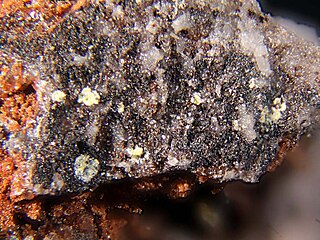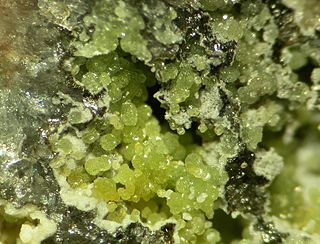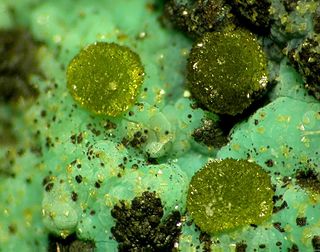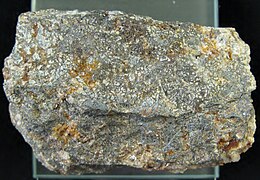
Bismuthinite is a mineral consisting of bismuth sulfide (Bi2S3). It is an important ore for bismuth. The crystals are steel-grey to off-white with a metallic luster. It is soft enough to be scratched with a fingernail and rather dense.

Tetradymite is a mineral consisting of bismuth, tellurium and sulfide, Bi2Te2S, also known as telluric bismuth. If sulfur is absent the mineral is tellurobismuthite and the formula is then Bi2Te3. Traces of selenium are usually present.

Litharge (from Greek lithargyros, lithos 'stone' + argyros 'silver' λιθάργυρος) is one of the natural mineral forms of lead(II) oxide, PbO. Litharge is a secondary mineral which forms from the oxidation of galena ores. It forms as coatings and encrustations with internal tetragonal crystal structure. It is dimorphous with the yellow orthorhombic form massicot. It forms soft (Mohs hardness of 2), red, greasy-appearing crusts with a very high specific gravity of 9.14–9.35. PbO may be prepared by heating lead metal in air at approximately 600 °C (lead melts at only 300 °C). At this temperature it is also the end product of heating of other lead oxides in air. This is often done with a set of bellows pumping air over molten lead and causing the oxidized product to slip or fall off the top into a receptacle, where it quickly solidifies in minute scales.

Loellingite, also spelled löllingite, is an iron arsenide mineral with formula FeAs2. It is often found associated with arsenopyrite (FeAsS) from which it is hard to distinguish. Cobalt, nickel and sulfur substitute in the structure. The orthorhombic lollingite group includes the nickel iron arsenide rammelsbergite and the cobalt iron arsenide safflorite. Leucopyrite is an old synonym for loellingite.

Bismite is a bismuth oxide mineral, bismuth trioxide or Bi2O3. It is a monoclinic mineral, but the typical form of occurrence is massive and clay-like with no macroscopic crystals. The color varies from green to yellow. It has a Mohs hardness of 4 to 5 and a specific gravity of 8.5 to 9.5, quite high for a nonmetallic mineral.

Rammelsbergite is a nickel arsenide mineral with formula NiAs2. It forms metallic silvery to tin white to reddish orthorhombic prismatic crystals, and is usually massive in form. It has a Mohs hardness of 5.5 and a specific gravity of 7.1.

Tellurobismuthite, or tellurbismuth, is a telluride mineral: bismuth telluride (Bi2Te3). It crystallizes in the trigonal system. There are natural cleavage planes in the (0001) direction as the crystal is effectively lamellar (layered) in that plane. The Mohs hardness is 1.5 – 2 and the specific gravity is 7.815. It is a dull grey color, which exhibits a splendent luster on fresh cleavage planes.

Bismuth subcarbonate (BiO)2CO3, sometimes written Bi2O2(CO3) is a chemical compound of bismuth containing both oxide and carbonate anions. Bismuth is in the +3 oxidation state. Bismuth subcarbonate occurs naturally as the mineral bismutite. Its structure consists of Bi–O layers and CO3 layers and is related to kettnerite, CaBi(CO3)OF. It is light-sensitive.

Russellite is a bismuth tungstate mineral with the chemical formula Bi2WO6. It crystallizes in the orthorhombic crystal system. Russellite is yellow or yellow-green in color, with a Mohs hardness of 3+1⁄2.

Bismuth(III) sulfide is a chemical compound of bismuth and sulfur. It occurs in nature as the mineral bismuthinite.

Bismoclite is a bismuth oxohalide mineral with formula BiOCl. It is the naturally occurring form of bismuth oxychloride. The name was derived from its chemical constituents. It is a secondary bismuth mineral first thought to be composed of bismuthyl ions (BiO+) and chloride anions, however, the existence of the diatomic bismuthyl ion is doubtful.
Xilingolite is a lead sulfide mineral with formula Pb3Bi2S6. It has a hardness of 3, a metallic luster, and usually exhibits a lead-grey color. It is a dimorph of lillianite, exhibiting increased Pb-Bi order and decreased symmetry.
Gananite (simplified Chinese: 赣南矿; traditional Chinese: 贛南礦; pinyin: gànnánkuàng) is a rare bismuth fluoride mineral form of bismuth trifluoride with a general formula of BiF3. Gananite is an isotropic mineral, it belongs to the space group P43m. This means that gananite does not show any colors in cross polarized light, because when polarized light passes through it, it does not split into two perpendicular rays. In other words, because gananite is an isometric mineral, it does not exhibit double refraction. Moreover, this tells us that this mineral is not birefringent. Its color in plane-polarized light is blackish-brown, and it does not show pleochroism.

Matlockite is a rare lead halide mineral, named after the town of Matlock in Derbyshire, England, where it was first discovered in a nearby mine. Matlockite gives its name to the matlockite group which consists of rare minerals of a similar structure.
Daubréeite is a rare bismuth oxohalide mineral with formula BiO(OH,Cl). It is a creamy-white to yellow-brown, soft, earthy clay–like mineral which crystallizes in the tetragonal crystal system. It is a member of the matlockite group.
Mawsonite is a brownish orange sulfosalt mineral, containing copper, iron, tin, and sulfur: Cu6Fe2SnS8.

Sillénite or sillenite is a mineral with the chemical formula Bi12SiO20. It is named after the Swedish chemist Lars Gunnar Sillén, who mostly studied bismuth-oxygen compounds. It is found in Australia, Europe, China, Japan, Mexico and Mozambique, typically in association with bismutite.

Waylandite is the phosphate analogue of arsenowaylandite and the aluminum analogue of zaïrite. The mineral was approved by the IMA in 1962, and was published the same year. Waylandite was named in honor of Edgar James Wayland. It is a member of the alunite supergroup, and a member of the plumbogummite – also known as crandallite – group. So far, only two bismuth-bearing members of the alunite supergroup are known, one of which is waylandite, alongside its ferric iron analogue zaïrite.

Bismuthyl — inorganic oxygen-containing singly charged ion with the chemical formula BiO+, is an oxycation of bismuth in the +3 oxidation state. Most often it is formed during the hydrolysis of trivalent bismuth salts, primarily nitrate, chloride and other halides. In chemical compounds, bismuthyl plays the role of a monovalent cation.

Eulytine (German: Eulytin from Ancient Greek: εΰλυτος, fusible, easily dissolved) or bismuth blende (obsolete) — one of the rarest minerals in nature, the composition is bismuth silicate with the calculation formula Bi4(SiO4)3 or Bi4Si3O12. The mineral forms isometric cubic crystals up to 2 mm in size, the supporting form of which is a tetrahedron or tristetrahedron. Among the varieties, there are also often concentric, fibrous or spherical aggregates of a very impressive appearance, which were previously called agricolites.
















